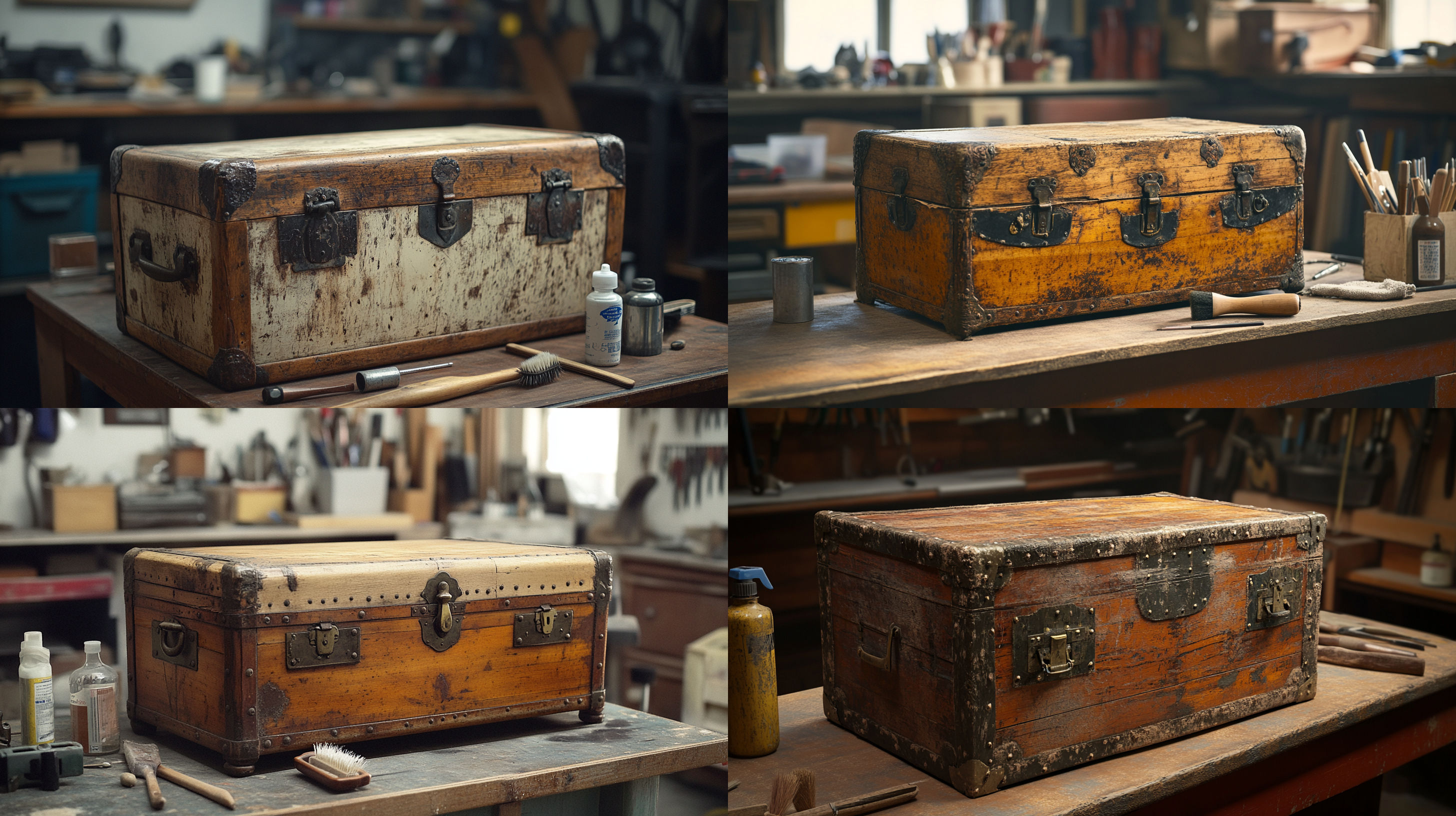Introduction to Flat-Top Antique Steamer Trunks
Antique steamer trunks represent fascinating pieces of history, combining practical utility with craftsmanship that tells the story of an era when travel was an elegant affair. Among the various styles, flat-top steamer trunks are particularly notable for their distinctive design and historical significance.
These rectangular trunks with their characteristic flat tops were designed for easy stacking during transit on steamships, trains, and other modes of transportation from the mid-19th to early 20th centuries. Their design prioritized practicality while still maintaining an aesthetic appeal that makes them valuable collectors’ items today.
In this comprehensive guide, we’ll walk you through the process of identifying authentic flat-top antique steamer trunks, understanding their historical context, and determining their potential value in today’s market.
The Historical Context of Flat-Top Steamer Trunks
Flat-top steamer trunks emerged during a transformative period in travel history. While the dome-top trunks were popular in earlier eras (particularly during stagecoach travel), the rise of steamship and train travel in the mid-to-late 1800s created a demand for luggage that could be stacked efficiently in cargo holds and train compartments.
Evolution of Steamer Trunks
- 1750-1850
Early Trunk Development
Travel trunks featured curved or dome tops, often covered in animal hide. These were designed primarily for stagecoach travel. - 1850-1880
Rise of Flat-Top Design
As train and steamship travel became more common, flat-top designs emerged for better stacking. Canvas or leather coverings with wooden slats for protection became standard. - 1880-1920
Golden Age of Trunk Manufacturing
Peak production period with numerous manufacturers. Advanced metal components, improved locks, and specialized internal compartments were introduced. - 1920-1940
Decline of Trunk Usage
As air travel emerged and lighter suitcases became popular, traditional steamer trunk production declined significantly.
The term “steamer trunk” itself refers to trunks designed for use on steamships, though they were equally useful on trains. The flat-top design was particularly valued for its ability to be stacked efficiently in the limited space of a ship’s cargo hold or a train compartment.
These trunks weren’t just practical luggage items; they were sturdy containers built to protect valuable belongings during long journeys across oceans and continents. Their construction reflected this purpose, with reinforced corners, sturdy locks, and durable materials designed to withstand the rigors of travel.
Key Identifying Features of Flat-Top Steamer Trunks
Shape and Design
The most obvious identifying feature of a flat-top steamer trunk is its rectangular shape with a completely flat top. Unlike dome-top or camelback trunks that feature a curved top, or slant-top (bevel-top) trunks with their angled tops, flat-top trunks have a perfectly level upper surface specifically designed for stacking.
Authentic flat-top steamer trunks typically feature:
- Rectangular box construction with reinforced corners
- Completely flat top and bottom surfaces
- Sturdy base with protective wooden slats or metal runners
- Height typically ranging from 13 to 24 inches
- Width usually between 30 and 40 inches
- Depth ranging from 17 to 22 inches
Flat-Top Trunk Identification Statistics
Materials and Coverings
The materials used in flat-top steamer trunks can provide important clues about their age and authenticity:
Material Identification Checklist
Look for these common materials used in authentic flat-top steamer trunks
- Canvas covering (often treated with oil or paint)
- Leather trim or full leather covering
- Metal (typically tin) covering or embossed metal sheets
- Wooden slats reinforcing the exterior
- Pine or other softwood for the trunk body
- Metal hardware with a characteristic patina
Many flat-top trunks were covered with canvas that was treated with oil, paint, or a combination to make it water-resistant. The canvas was often decorated with stripes or patterns, and in some cases, featured the manufacturer’s name or logo.
Later trunks (particularly from the 1880s onward) might feature metal coverings, often embossed with decorative patterns. These metal-covered trunks were extremely durable but were also heavier than their canvas-covered counterparts.
Hardware Components
The hardware on a flat-top steamer trunk can be one of the most reliable indicators of its authenticity and age:
Locks and Latches: Most genuine antique trunks feature brass or iron locks, often with elaborate mechanisms. Many manufacturers had distinctive lock styles.
Corner Protectors: Metal corner protectors (or “caps”) were standard features designed to protect the trunk during transit. The style and material of these corners can help identify both the age and maker of the trunk.
Handles: Side handles were typically made of leather, wood, or metal. Their style and attachment method can provide clues about the trunk’s age and origin.
Hinges: The style and construction of the hinges can be particularly revealing. Early trunks often had simple strap hinges, while later models featured more sophisticated designs.
Wooden Slats: Many flat-top trunks featured wooden slats on the exterior, designed to provide additional protection. The arrangement and number of these slats can sometimes help identify specific manufacturers.
Identifying Trunk Manufacturers
Manufacturer Labels and Marks
The most direct way to identify a trunk’s manufacturer is through a label or mark. These were typically found:
- Inside the lid of the trunk
- On the bottom of the trunk
- Sometimes stamped into the hardware itself

Prominent American flat-top steamer trunk manufacturers included:
- Louis Vuitton (high-end luxury trunks)
- M.M. Secor
- Seward Trunk & Bag Co.
- Excelsior
- Likly
- Mendel & Son
- Hartmann
- Oshkosh
- Belber
- Haskell Brothers
- Taylor Trunk Works
- Leatheroid
Each manufacturer had distinctive construction characteristics, hardware styles, and interior treatments that can help with identification even when labels are missing or illegible.
Patent Dates and Construction Methods
Patent dates stamped on locks, latches, or other hardware can provide valuable dating information. Many manufacturers stamped their hardware with patent dates, which can establish the earliest possible production date for a trunk.
Additionally, certain construction methods were characteristic of specific time periods:
Pre-1870s: Typically featured handmade construction with nailed wooden components and simple lock mechanisms.
1870s-1890s: Increased use of machine-made components, more elaborate hardware, and standardized sizing.
1890s-1920s: More sophisticated interior compartments, improved lock systems, and specialized designs for different travel purposes.
Interior Features and Compartments
Flat-top steamer trunks were designed to be practical storage solutions for travelers, and their interiors reflected this purpose. Common interior features include:
Tray Systems
Many flat-top trunks included one or more removable trays that fit inside the main compartment. These trays were designed to organize smaller items and make them easily accessible without having to unpack the entire trunk.
The construction materials and design of these trays can help identify both the trunk’s age and manufacturer:
- Early trays were often simple wooden constructions with basic dividers
- Later trays might feature more elaborate compartmentalization with specialized sections for specific items
- High-end trunks might have multiple trays with custom-fitted spaces for particular accessories
Interior Coverings
The materials used to line the interior of a flat-top trunk can provide valuable dating information:
Paper Linings: Common in trunks from the 1850s through the 1880s. These might feature decorative prints or the manufacturer’s advertisements.
Fabric Linings: Became more common from the 1880s onward. These might include cotton, linen, or even more luxurious fabrics in high-end trunks.
Compartmentalization: Later trunks (particularly from the 1890s onward) often featured increasingly sophisticated interior compartments designed for specific clothing items or travel necessities.
Specialized Features
Some flat-top steamer trunks were designed for specific purposes and include specialized interior features:
- Wardrobe Trunks: Featured hanging sections for garments
- Artist Trunks: Included specialized compartments for paints, brushes, and canvases
- Salesman Trunks: Designed to display merchandise samples
- Military Trunks: Often featured reinforced construction and specialized compartments for uniforms and equipment
Age Determination Techniques

Construction Methods
The way a trunk was constructed can provide valuable clues about its age:
Hand vs. Machine Nails: Earlier trunks (pre-1880s) often feature hand-forged nails with irregular heads, while later trunks have machine-cut nails with more uniform appearance.
Joinery Techniques: Earlier trunks typically feature simpler joinery methods, while later trunks might include more sophisticated techniques.
Wood Types: The type of wood used for the body and slats can sometimes indicate a trunk’s age and origin. Pine was commonly used, but other woods might indicate specific regions or manufacturers.
Hardware Evolution
The style and construction of hardware components evolved over time:
Lock Mechanisms: Early locks (pre-1870s) were typically simpler in design, while later locks featured more sophisticated mechanisms with multiple-lever systems.
Corner Protectors: The style and material of corner protectors evolved from simple iron or brass corners to more decorative designs in later years.
Handle Attachments: The method of attaching handles changed over time, from simple leather straps to more complex metal-reinforced designs.
Material Analysis
The materials used in a trunk’s construction and covering can provide dating clues:
Canvas Treatments: The specific methods used to treat canvas coverings evolved over time, from simple oil treatments to more sophisticated waterproofing compounds.
Metal Coverings: The techniques used to emboss and attach metal coverings became more refined in later years.
Interior Materials: As mentioned earlier, interior linings evolved from simple paper to more elaborate fabric treatments.
Essential Resources for Flat-Top Steamer Trunk Identification
Antique Trunks: Identification & Value Guide
Comprehensive guide covering trunk identification features, historical context, and valuation factors for collectors and enthusiasts.
wikiHow: How to Value Antique Trunks
Step-by-step guide for determining the age, type, and value of antique trunks, including flat-top steamer models.
Of Graveyards and Things: Dating Antique Steamer Trunks
Detailed techniques for determining the age of antique steamer trunks based on construction methods and historical markers.
La Malle en Coin: Trunk Museum
Museum collection featuring different types of antique trunks including flat-top models, with historical context and identification information.
1stDibs: Steamer Trunk Identification Guide
Expert advice from antique dealers on identifying authentic steamer trunks and determining their value in the current market.
SeacoastNH: Antique Trunks Research
Database of trunk makers and historical information to help with identification of antique flat-top and other style trunks.
Collecting and Investment Considerations
Market Trends
The market for antique flat-top steamer trunks has shown several notable trends in recent years:
Increased Interest in Repurposing: Many buyers are seeking trunks that can be repurposed as coffee tables, storage solutions, or decorative elements in interior design.
Premium for Unusual Examples: Trunks with unique features, rare makers, or exceptional original condition command increasing premiums.
Luxury Brand Appreciation: Trunks from premium makers like Louis Vuitton have seen substantial price increases, sometimes functioning more as investment pieces than decorative items.
Condition Sensitivity: The gap in value between well-preserved examples and those needing significant restoration has widened.
Building a Collection
For those building a collection of flat-top steamer trunks, several approaches might prove rewarding:
Specialization by Maker: Focusing on trunks from a specific manufacturer allows for deeper expertise and potentially more valuable specialized knowledge.
Era-Specific Collection: Concentrating on trunks from a particular time period can create a cohesive collection that illustrates the evolution of travel during that era.
Functional Collection: Some collectors focus on trunks that can serve practical purposes in their homes while appreciating in value.
Documentation-Focused Collection: Seeking trunks with original labels, travel stickers, or documented provenance can create a collection with significant historical interest.
Storage and Display Considerations
Proper storage and display are essential for maintaining the condition and value of flat-top steamer trunks:
Climate Control: Avoid extreme temperature and humidity fluctuations, which can damage wood, canvas, and metal components.
Light Exposure: Protect trunks from direct sunlight, which can fade coverings and damage interior linings.
Support: Ensure adequate support under trunks used as furniture to prevent stress on the structure.
Handling: When moving trunks, lift from the bottom rather than using the original handles, which may be weakened with age.
Cleaning: Use appropriate conservation techniques for cleaning, avoiding harsh chemicals or excessive moisture.
Common Questions About Flat-Top Steamer Trunk Identification
How can I identify an antique steamer trunk?
To identify an antique steamer trunk, examine several key features:
- Look for maker’s marks or labels inside the lid, along the interior, or on the bottom of the trunk.
- Examine the hardware (locks, hinges, corner protectors) for distinctive designs or patent dates.
- Assess the construction methods, including the types of nails or screws used.
- Check the materials – authentic trunks typically feature canvas, leather, or metal coverings with characteristic aging patterns.
- Evaluate the interior features, including trays, compartments, and lining materials.
The combination of these features can help determine the manufacturer, age, and authenticity of your steamer trunk.
How do I value an antique flat-top steamer trunk?
Valuing an antique flat-top steamer trunk involves considering several factors:
- Maker: Trunks from prestigious manufacturers like Louis Vuitton command significant premiums over lesser-known makers.
- Condition: Original hardware, intact canvas or covering, functional locks, and well-preserved interiors significantly increase value.
- Rarity: Unusual sizes, specialized designs, or trunks from less common manufacturers may be more valuable.
- Provenance: Documented history, especially connections to notable individuals or historical events, can enhance value.
- Originality: Trunks with original components typically fetch higher prices than heavily restored examples.
For a precise valuation, consider consulting a professional appraiser specializing in antique furniture or trunks, or compare similar examples at recent auctions and antique sales.
How old is an antique steamer trunk?
Antique steamer trunks typically date from the mid-19th century to the early 20th century, roughly 1850 to 1930. This period corresponds to the golden age of steamship and train travel, when these trunks were actively manufactured and used.Flat-top steamer trunks specifically became popular from around 1870 onward, when the need for stackable luggage in train compartments and steamship cargo holds became increasingly important.
The term "antique" generally applies to items at least 100 years old, so most genuine steamer trunks now qualify as true antiques. Various construction details, hardware styles, and materials can help narrow down the age of a specific trunk within this period.
What features distinguish flat-top trunks from other antique trunk styles?
Flat-top trunks differ from other antique trunk styles in several key ways:
-
Top Shape: As the name suggests, flat-top trunks have a completely flat upper surface, unlike dome-top trunks (rounded top), camelback trunks (center-humped top), or bevel-top/slant-top trunks (angled top).
-
Purpose: Flat-top trunks were specifically designed for efficient stacking during transport on trains and steamships.
-
Construction: They typically feature reinforced corners and edges to withstand the weight of other trunks stacked on top.
-
Era: While other trunk styles existed earlier, flat-top trunks became particularly common from the 1870s through the early 1900s.
Interior Design: Flat-top trunks often featured practical interior layouts with removable trays and compartments designed for efficient packing.
Are antique steamer trunks worth anything?
Yes, antique steamer trunks can be quite valuable, with prices ranging from under $100 for basic, damaged examples to $15,000 or more for rare trunks from prestigious makers in excellent condition.Value factors include:
- Maker: Luxury brands like Louis Vuitton, Goyard, or Moynat command the highest prices.
- Condition: Well-preserved trunks with original hardware and minimal damage are worth significantly more.
- Rarity: Unusual designs, sizes, or features increase value.
- Originality: Unaltered trunks with original components are preferred by serious collectors.
- Provenance: Documented history can significantly enhance value.
Even modest flat-top steamer trunks in good condition typically sell for $200-$600, while exceptional examples from well-regarded American manufacturers like Hartmann or Seward can reach $1,000-$3,000.
How do I restore an antique flat-top steamer trunk?
Restoring an antique flat-top steamer trunk requires a careful approach to preserve its value and authenticity:
Assessment: Document the current condition and identify all issues needing attention.
Cleaning: Gently clean exterior and interior surfaces using appropriate methods for each material (wood, metal, canvas, etc.).
Hardware: Clean and lubricate hinges, locks, and latches. Replace missing hardware with period-appropriate pieces when possible.
Structural Repairs: Address any structural issues with the wooden frame using traditional woodworking techniques.
Covering Repairs: For canvas coverings, clean carefully and make minimal repairs. For severely damaged coverings, consider consulting a professional before replacement.
Interior Work: Clean interior linings and repair as needed. If replacement is necessary, use historically appropriate materials.
For valuable trunks or those with significant damage, consulting with a professional conservator or restorer specializing in antique trunks is recommended to avoid diminishing the trunk’s value through improper restoration.
How can I tell if my flat-top trunk is a reproduction?
To identify reproduction flat-top trunks, look for these tell-tale signs:
Modern Materials: Presence of plywood, particleboard, or modern adhesives not used in authentic period trunks.
Hardware Inconsistencies: Reproduction hardware often lacks the weight, detail, or appropriate patina of authentic pieces. Look for machine-made screws with perfectly centered slots or Phillips-head screws (not used in antique trunks).
Uniform Aging: Authentic trunks show different wear patterns on different parts based on use, while artificially aged reproductions often have too-uniform distressing.
Construction Methods: Modern assembly techniques like staples, precision machine cuts, or contemporary joinery methods weren’t used in antique trunks.
Interior Details: Reproductions often have interiors that don’t match the expected layout or materials for the style and period they’re imitating.
Weight: Authentic antique trunks are typically heavier than modern reproductions due to the solid wood construction and substantial hardware.
Perfect Condition: If a supposedly "antique" trunk shows almost no wear or aging despite being 100+ years old, be suspicious.
What were flat-top steamer trunks originally used for?
Flat-top steamer trunks were originally designed as practical luggage for long-distance travel during the late 19th and early 20th centuries. Their specific purposes included:
Ocean Travel: They were used on steamships (hence "steamer" trunks) for transatlantic and other long sea voyages, designed to be stacked efficiently in cargo holds.
Railway Travel: As train travel expanded, these trunks were ideal for storage in train compartments and baggage cars.
Extended Stays: Unlike smaller luggage, these trunks could hold enough belongings for extended stays abroad, including multiple outfits and personal necessities.
Specialized Uses: Some flat-top trunks were designed for specific professions or purposes, such as military officer trunks, salesman sample trunks, or artist trunks with specialized compartments.
Immigration: Many immigrants brought their belongings to America in these trunks, which sometimes represented their only substantial possession.
The flat top was specifically designed to allow efficient stacking of multiple trunks, maximizing storage space in the limited confines of ships and trains.
Conclusion: The Enduring Appeal of Flat-Top Steamer Trunks
Flat-top antique steamer trunks stand as remarkable artifacts from an era when travel was both more arduous and more elegant. These practical yet beautiful pieces of luggage tell stories of ocean voyages, transcontinental train journeys, and the personal histories of those who owned them.
For collectors and enthusiasts, the appeal of these trunks lies in their perfect combination of historical significance, practical utility, and aesthetic appeal. Whether displayed as decorative pieces, repurposed as functional furniture, or preserved as part of a serious collection, flat-top steamer trunks continue to fascinate with their craftsmanship and historical connections.
The process of identifying, evaluating, and potentially restoring these trunks connects us directly with the craftsmanship and design sensibilities of a bygone era. Each authentic trunk represents not just a beautiful object, but a tangible link to the golden age of travel and the stories of those who journeyed with these sturdy companions.
As you encounter these fascinating artifacts in antique shops, estate sales, or perhaps forgotten in an attic, the knowledge to properly identify and appreciate their unique characteristics enables you to participate in preserving this specific aspect of our material cultural heritage for future generations.




